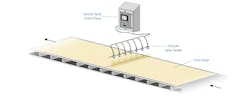In today's data-crazed, efficiency-driven manufacturing industry, neglected processes and unnoticed waste should be rare. But in the spraying world, they are still far too common.
After decades of lean and continuous improvement efforts, plus half a decade of smart manufacturing investment, it can seem like there is nowhere left in the plant that hasn't been investigated, improved, and optimized for efficient, cost-effective production.
And yet, even in this data-crazed, efficiency-driven industry, there remain enormous blind spots on the plant floor, running in the dark against the entire improvement narrative of the industry.
As we keep finding, one of the most wasteful blind spots is found in spraying equipment.
"Most people don't think about spray nozzles very much," explains Mike Cerney, an applications engineer at Spraying Systems Co., who thinks a great deal about spray nozzles.
"In the grand scheme of equipment in their plants, spray nozzles are just not a big concern," he says. "Customers don't think they have that big of an effect."
But that, of course, is crazy. Every part of a manufacturing plant can—and should—be optimized, all the way from CNCs to light fixtures. Everything has an impact.
Spraying equipment—often the last step in the manufacturing process before the product meets the consumer—is no different.
Making Dough
To illustrate this point, Cerney highlights a project he worked on at a private pizza dough manufacturer.
This frozen dough maker, he explains, applies soybean oil to their product before it is baked to get the crust just right. And, before he intervened, they did so in the least optimized way possible.
"They were dumping—literally dumping—oil onto the dough through these large valves and then just spreading it on," he explains. "They had no idea how much oil they were applying."
This blind spot had three direct consequences for the company that were passing unnoticed.
First, just like any food manufacturer, the company was required to post an accurate caloric count of their products on the label. However, since they didn't know how much high-calorie oil they were applying, they couldn't come close to an accurate estimate on this data. Which is worrisome both for the manufacturer and the consumer.
Then, of course, there is the waste. No matter how cheap the product being sprayed is—even if it's just water—the cost of overuse can quickly add up.
And finally, the company was actually experiencing full mechanical breakdowns from the process.
"They were dumping so much oil on the dough that it would actually go over the edges and destroy the belts," Cerney explains. "They were shutting down the line three to four times per year to change the belts."
So much for spray nozzles not having a big effect.
The Fix
To remedy the issue, Cerney and his team brought in a fairly sophisticated system—an AutoJet Spray System with PulsaJet spray nozzles, complete with a custom-coded PLC and Precision Spray Control that automatically adjusts the precise coverage to whatever comes down the line, however fast it comes.
So, all the bells and whistles—basically exactly the opposite of the company's previous system.
It was a big investment, but one, Cerney says, that paid off well.
According to a case study published by Spraying Systems Co., the dough manufacturer saved $38,000 in wasted soybean oil in one year, plus an additional $13,000 on conveyor belt replacement. That means—even without taking downtime into account—the company was able to save $51,000 a year with one system change.
The Road to Enlightenment
This is a pretty extreme example. Cerney estimates that 80 to 90% of customers can probably see improvements with basic preprogrammed spray controllers and nozzles. But this ignorance-to-enlightenment story still highlights the general issue at hand, he says.
"There are big advantages to getting control over your spraying system," he explains. "Control means you can measure and manage how much coating you're applying, be it an oil, a topping, a glaze, or anything else. Precision Spray Control can reduce scrap, save on chemical costs, and improve efficiency."
And that seems obvious. After all, this is exactly what continuous improvement and smart manufacturing are supposed to do for us. But for some reason, it seems to take a little extra push—and pain—to open eyes to it here.
"Intellectually, customers often just don't see the issue or the potential to change it," Cerney says. "They only begin to see it when their pain level gets high enough—when they've done everything else they can do to improve their process and they are still having problems with scrap, or they take a look at their chemical consumption and realize it's ridiculous."
Basically, he says, it comes down to this: "Customers don't know what they don't know. Or they don't know that new technology has been developed."
In either case, he says, it's his job to enlighten them. And potentially save them a lot of headaches in the process.












